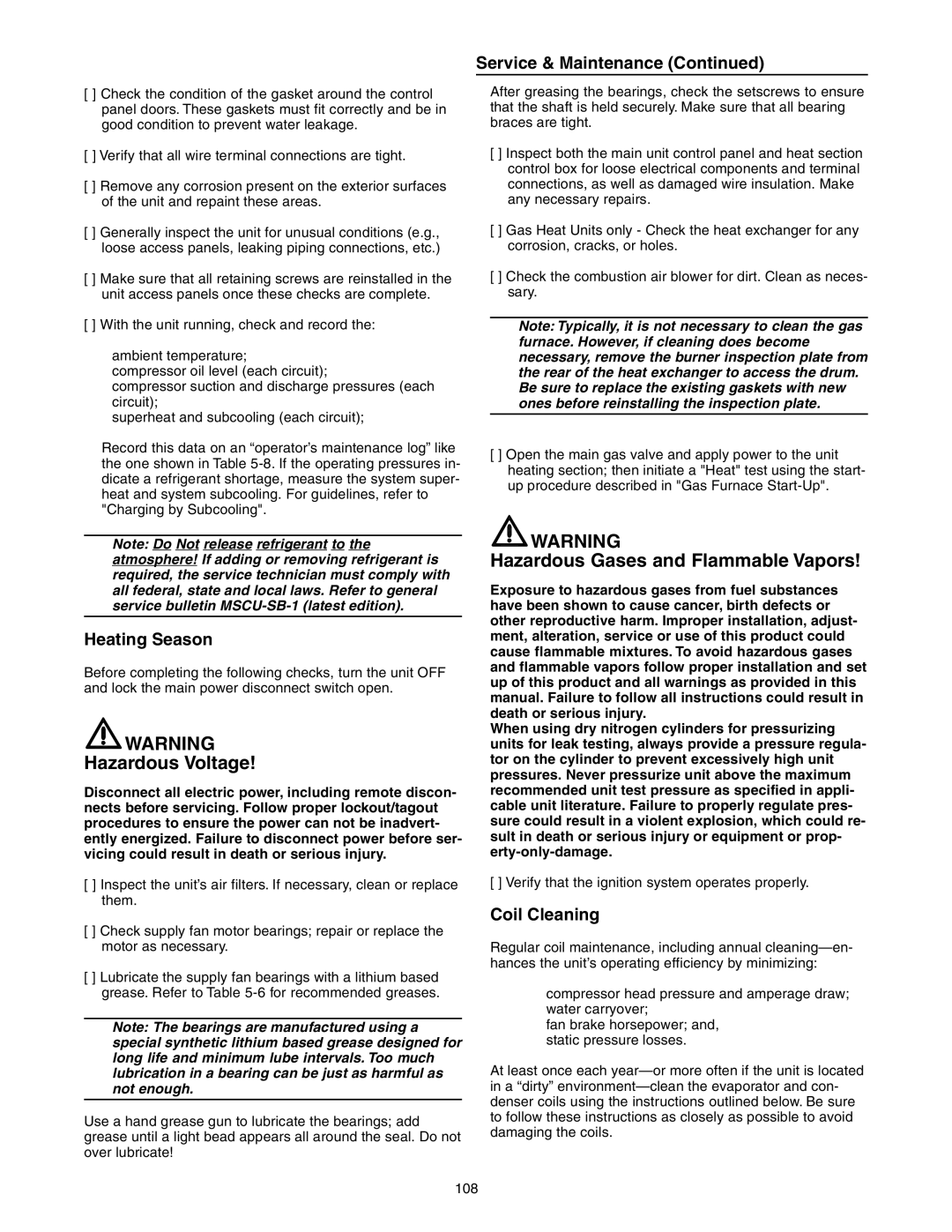
[ ] Check the condition of the gasket around the control panel doors. These gaskets must fit correctly and be in good condition to prevent water leakage.
[ ] Verify that all wire terminal connections are tight.
[ ] Remove any corrosion present on the exterior surfaces of the unit and repaint these areas.
[ ] Generally inspect the unit for unusual conditions (e.g., loose access panels, leaking piping connections, etc.)
[ ] Make sure that all retaining screws are reinstalled in the unit access panels once these checks are complete.
[ ] With the unit running, check and record the:
ambient temperature; compressor oil level (each circuit);
compressor suction and discharge pressures (each circuit);
superheat and subcooling (each circuit);
Record this data on an “operator’s maintenance log” like the one shown in Table
Note: Do Not release refrigerant to the atmosphere! If adding or removing refrigerant is required, the service technician must comply with all federal, state and local laws. Refer to general service bulletin
Heating Season
Before completing the following checks, turn the unit OFF and lock the main power disconnect switch open.
![]() WARNING
WARNING
Hazardous Voltage!
Disconnect all electric power, including remote discon- nects before servicing. Follow proper lockout/tagout procedures to ensure the power can not be inadvert- ently energized. Failure to disconnect power before ser- vicing could result in death or serious injury.
[ ] Inspect the unit’s air filters. If necessary, clean or replace them.
[ ] Check supply fan motor bearings; repair or replace the motor as necessary.
[ ] Lubricate the supply fan bearings with a lithium based grease. Refer to Table
Note: The bearings are manufactured using a special synthetic lithium based grease designed for long life and minimum lube intervals. Too much lubrication in a bearing can be just as harmful as not enough.
Use a hand grease gun to lubricate the bearings; add grease until a light bead appears all around the seal. Do not over lubricate!
Service & Maintenance (Continued)
After greasing the bearings, check the setscrews to ensure that the shaft is held securely. Make sure that all bearing braces are tight.
[ ] Inspect both the main unit control panel and heat section control box for loose electrical components and terminal connections, as well as damaged wire insulation. Make any necessary repairs.
[ ] Gas Heat Units only - Check the heat exchanger for any corrosion, cracks, or holes.
[ ] Check the combustion air blower for dirt. Clean as neces- sary.
Note: Typically, it is not necessary to clean the gas furnace. However, if cleaning does become necessary, remove the burner inspection plate from the rear of the heat exchanger to access the drum. Be sure to replace the existing gaskets with new ones before reinstalling the inspection plate.
[ ] Open the main gas valve and apply power to the unit heating section; then initiate a "Heat" test using the start- up procedure described in "Gas Furnace
![]() WARNING
WARNING
Hazardous Gases and Flammable Vapors!
Exposure to hazardous gases from fuel substances have been shown to cause cancer, birth defects or other reproductive harm. Improper installation, adjust- ment, alteration, service or use of this product could cause flammable mixtures. To avoid hazardous gases and flammable vapors follow proper installation and set up of this product and all warnings as provided in this manual. Failure to follow all instructions could result in death or serious injury.
When using dry nitrogen cylinders for pressurizing units for leak testing, always provide a pressure regula- tor on the cylinder to prevent excessively high unit pressures. Never pressurize unit above the maximum recommended unit test pressure as specified in appli- cable unit literature. Failure to properly regulate pres- sure could result in a violent explosion, which could re- sult in death or serious injury or equipment or prop-
[ ] Verify that the ignition system operates properly.
Coil Cleaning
Regular coil maintenance, including annual
compressor head pressure and amperage draw; water carryover;
fan brake horsepower; and, static pressure losses.
At least once each
108
